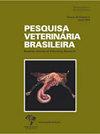Occurrence of Salmonella spp. in fecal samples from foals with and without diarrhea in the state of São Paulo: microbiological diagnosis, antimicrobial susceptibility profile, and molecular detection
IF 0.8
4区 农林科学
Q3 VETERINARY SCIENCES
引用次数: 0
Abstract
ABSTRACT: The present study investigated Salmonella spp. in the feces of 200 foals up to one year of age (100 with clinical signs of diarrhea and 100 without clinical signs of diarrhea). Bacteriological culture, serotyping, antimicrobial susceptibility, and real-time PCR (qPCR SYBR® Green or a TaqMan®) for detecting the invA gene (with and without a selective pre-enrichment step in tetrathionate broth) were performed. Bacterial culture revealed 15% (n=30) of positive animals (21 animals with diarrhea and nine without diarrhea). Among the 30 isolates, 13 different serovars were identified: S. Infantis, S. Minnesota, S. I.4,5,12:i:-; S. Anatum, S. Cerro, S. Oranienburg, S. Braenderup, S. Give, S. Newport, S. IIIb 61:c:z35, S. 109:-:1.5, S. I.4.12:d:-, S. I.6.8:-:-. Multidrug resistance was found in 43.33% (n=13) of the isolates, with one isolate obtained from animals without diarrhea and 12 isolates from animals with diarrhea. All qPCR techniques used in the study classified more samples as positive for Salmonella spp. than the bacterial culture of feces. In addition, all qPCR techniques detected more positive animals in the diarrhea group than in the diarrhea-free group. The results confirm the utility of the qPCR method without the pre-enrichment step in tetrathionate as a rapid test for Salmonella spp. in carrier animals. In animals with clinical signs of diarrhea, it can be combined with bacterial culture (antimicrobial susceptibility testing and serotyping). The isolation of Salmonella spp. in nine animals without diarrhea confirms the importance of asymptomatic carrier animals in the epidemiology of the disease. The multidrug resistance observed highlights the importance of rational antimicrobial use in horses and adopting biosecurity protocols that are efficacious in controlling the spread of infections between animals and zoonotic transmission in farms.在圣保罗州有和没有腹泻的马驹粪便样本中沙门氏菌的发生:微生物学诊断、抗菌药物敏感性谱和分子检测
摘要:本研究对200匹1岁以下马驹粪便中的沙门氏菌进行了调查,其中100匹有腹泻临床症状,100匹无腹泻临床症状。进行细菌学培养、血清分型、抗菌敏感性和实时荧光定量PCR (qPCR SYBR®Green或TaqMan®)检测invA基因(在四硫酸盐肉汤中有或没有选择性预富集步骤)。细菌培养显示15% (n=30)阳性动物(21只腹泻动物,9只无腹泻动物)。在30株分离株中鉴定出13种不同的血清型:S. Infantis、S. Minnesota、S. i .4、5、12:i:-;S. Anatum, S. Cerro, S. Oranienburg, S. Braenderup, S. Give, S. Newport, S. IIIb 61:c:z35, S. 109:-:1.5, S. 4.12:d:-, S. 6.8:-:-。43.33% (n=13)的分离株出现多重耐药,其中1株来自无腹泻动物,12株来自有腹泻动物。研究中使用的所有qPCR技术都将沙门氏菌阳性的样本分类为粪便细菌培养的样本。此外,所有qPCR技术在腹泻组中检测到的阳性动物多于无腹泻组。结果表明,无需四硫酸盐预富集步骤的qPCR方法可以快速检测携带动物中的沙门氏菌。对有腹泻临床症状的动物,可结合细菌培养(抗菌药敏试验和血清分型)。在9只无腹泻动物中分离出沙门氏菌,证实了无症状载体动物在该病流行病学中的重要性。所观察到的多重耐药性突出了在马中合理使用抗微生物药物和采用有效控制动物间感染传播和农场人畜共患病传播的生物安全规程的重要性。
本文章由计算机程序翻译,如有差异,请以英文原文为准。
求助全文
约1分钟内获得全文
求助全文
来源期刊

Pesquisa Veterinaria Brasileira
农林科学-兽医学
CiteScore
1.30
自引率
16.70%
发文量
41
审稿时长
9-18 weeks
期刊介绍:
Pesquisa Veterinária Brasileira - Brazilian Journal of Veterinary Research (http://www.pvb.com.br), edited by the Brazilian College of Animal Pathology in partnership with the Brazilian Agricultural Research Organization (Embrapa) and in collaboration with other veterinary scientific associations, publishes original papers on animal diseases and related subjects. Critical review articles should be written in support of original investigation. The editors assume that papers submitted are not being considered for publication in other journals and do not contain material which has already been published. Submitted papers are peer reviewed.
The abbreviated title of Pesquisa Veterinária Brasileira is Pesqui. Vet. Bras.
 求助内容:
求助内容: 应助结果提醒方式:
应助结果提醒方式:


